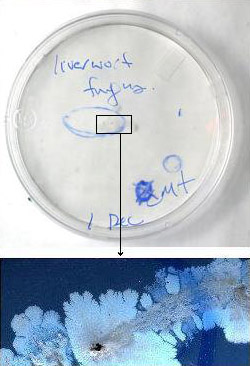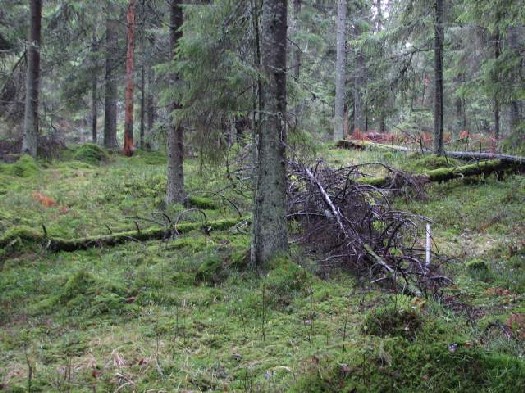Mystery liverwort fungus, chapter 3
Now, our attempt to identify the liverwort fungus (see part 1 and part 2) splits along several parallel paths.

After 10 days, there is no fungal growth in the attempted culture, just blobby bacterial colonies. Any hopes of using a culture to better understand micromorphology, or as a source of DNA for molecular analysis, are for now a dead end. Maybe this fungus does not grow in culture, or it was dead when it arrived. Maybe I used the wrong growth medium, or the wrong incubation temperature. But because no fungus grew, we can use the tissue directly for molecular work and hope that any fungal DNA sequences that result really represent our fungus and not an unnoticed contaminant. So I move those little blips of fungus and liverwort tissue up off the agar into a DNA extraction kit. My colleague, Molecule Man, has the real expertise on DNA extraction, PCR, and DNA sequencing. It might be messy because there will probably be plant and bacterial DNA as well …
Meanwhile, the morphology leads along two different paths. The first route is indirect, to consider two Ascomycete groups (and then reluctantly a third) notorious for making small, dark asexual structures on living leaves. One group is known colloquially as the sooty moulds (formally the Capnodiales), and the other group, the Mycosphaerellales, lacks a common name (but could be the name of an Irish pub). The second route is to dive directly into the literature on mould micromorphology.
Although this fungus is an anamorph (apparently), maybe known sexual fungi (teleomorphs) have anamorphs like this. Where there are taxonomic groups, there are sometimes experts. Students know about mentors, but how many are aware of the more exalted version, the doyen? A doyen is kind of a grand-mentor, the celebrated expert of an academic field, the one person whose pronouncements are gold. Gandalf-like scientists. Doyen: This is a good word to know. If you have one around, you are lucky.
I have to walk only five minutes to see the doyen of the sooty moulds. Most sooty moulds make complicated, dark masses of hyphae and spores, and there are often several species and genera all growing together in a large lump. In New Zealand, sooty moulds are obvious … the Kiwis used to refer to them as black moss. In this picture, the black on the trees behind the sheep is entirely sooty mould colonies. The insets give more detail of the colonies close up.

But some soots are inconspicuous, like our liverwort friend…
When the doyen saw the picture of the liverwort fungus, he suggested a couple of genera to consider, but did not recall having seen such a fungus. He suggested consulting a French monograph entirely dedicated to the fungal parasites of mosses (4). Who could have imagined there would be such a book? Unfortunately, this book is not in our library, but guess what? Our fearless blog-leader had the book in the library next to her office. I gave her the Friday Afternoon Task of surfing through it in search of something familiar. Before going home for supper, she reported that the fungus seemed not to be there, but that she would take the book home and look through it some more in the bath tub, or if she had trouble falling asleep.
My friend who works on the Mycosphaerellales lives in Germany and is too young to be considered a doyen (but he will be one some day). He’s a very reliable email correspondent. He has written book after book on the microscopic fungi growing on leaves. If anyone has seen this fungus before, this is the guy. The next day, he wrote back with … “Very interesting fungus, but I have never seen any comparable hyphomycete.” And then he mentioned that he too had the moss parasite book and could not find the fungus there either.
One last Ascomycete group to consider is the vast, confusing taxonomic wonderland now known as the class Dothideomycetes. As our knowledge increases, more and more moulds, especially the darkly pigmented ones, are found to be related to this class. If we get some DNA sequences, I might have to dive into this murky pond. However, one of the doyens of the Dothideomycetes has an office next door to the doyen of the sooty moulds. When he saw the pictures, he laughed and suggested it looked like something for Fungal Planet.
The second possible pathway to identification, and the most direct one, is to consider the asexual morphology. Because of my experience with asexual fungi (anamorphs) that make synnemata, I know there is no way to identify this fungus using the literature on what are usually referred to as moulds, or more formally, the Hyphomycetes. After more than 20 years, most of the known synnematous genera are packed into my head, either from the examination of specimens or cultures, or through the obsessive reading of scientific literature. But the anamorphs with closed fruiting bodies, known as the Coelomycetes, are a mystery to me. For these, I need the literature. Fortunately, there is a 1980 monograph published by Brian Sutton (5). With this book, I take the liverwort fungus through the keys in every possible direction that seems to make sense. When that fails, I flip through the whole book looking at the pictures. No luck. So this avenue is a dead end for now. Continuing in this direction, trying to find a logical path through the widely spread, individual articles in the specialized taxonomic literature of the past 200 years, is too horrifying to contemplate.
So far, these parallel morphological paths, through three different orders of Ascomycetes, and the literature on anamorphs, have led to dead ends. The convergence of two morphological paths on the same book, a host-defined rather than phylogeny-defined monograph, leads to a final (at least for this week) potential identification pathway: the host index. This liverwort is truly an obscure host. There are hundreds of fungi reported from wheat or pines, but how many would be reported from Ptilidium pulcherrimum? I check out the huge American host index (1), the Canadian equivalent (2), and an old European one (3). How many fungi are reported on Ptilidium? The grand total is zero. Nada. Bupkus. There are also specimen databases on-line that allow you to search institutional collections for fungi on specific hosts. I search the US National Fungus Collections, one of the world’s largest fungal collections, for specimens on Ptilidium. The grand total is zero. Nada. Bupkus.

There are many other herbaria to search, several other host indices to check, but I am getting tired and there might be pizza waiting. I will keep trolling, hoping to find some obscure publication that might bring me to the right place. showing the pictures to colleagues and strangers at bus stops and in shopping malls, hoping someone will shout, “I know that!” For the first time in decades, I will sit on Santa’s knee and ask him for ‘The Answer’ for Christmas…
Continued in Chapter 4
- Farr, D.F., G. F. Bills, G. P. Chamuris, and A.Y. Rossman. 1989. Fungi on Plants and Plant Products in the United States. The American Phytopathological Society, St. Paul, Minnesota, USA [this is a book but the database is on-line at the US National Fungus Collections here].
- Ginns, J. 1980. Compendium of plant disease and decay fungi in Canada 1960-1980. Agriculture Canada, Ottawa.
- Oudemans, C.A.J.A. (1919–1924): Enumeratio Systemica Fungorum. Vol. 1 (1919); vol. 2 (1920); vol. 3 (1921); vol. 4 (1923); vol. 5 (index, 1924). M. Nijoff, The Hague.
- Racovitza, A. 1959. Étude systématique et biologique des champignons bryophiles. Mem. Mus. Natl. Hist. Nat. Ser. B, 10: 1-288.
- Sutton, B.C. (1980) The Coelomycetes. Fungi Imperfecti with Pycnidia, Acervuli and Stromata, Commonwealth Mycological Institute, Kew, Surrey, UK.
The photo of the Finnish forest is by Anne Lesonen, an MSc student at the University of Turku. The host of our fungus is the liverwort Ptilidium, which festoons logs such as this one.
Note: This was written 15 December 2006, but not posted until January 3 2007.



[…] continued in Part 3… […]
OMG, the suspense is killing me!
If it is a new genus, you must you name it Blogomyces!
[…] chapter 3, in which we meet Molecule Man and a sheep […]
[…] chapter 3, in which we meet Molecule Man and a sheep […]